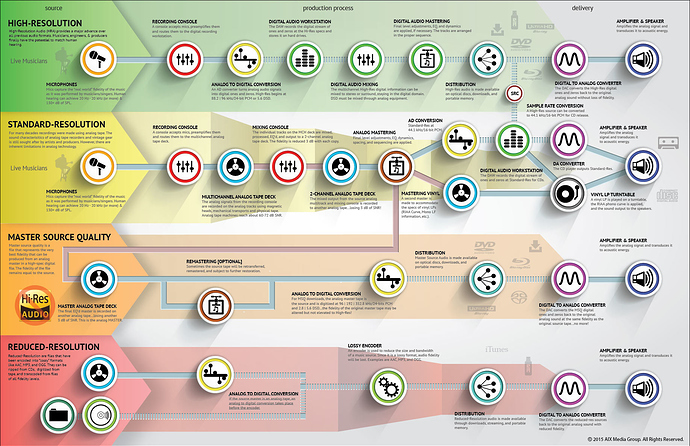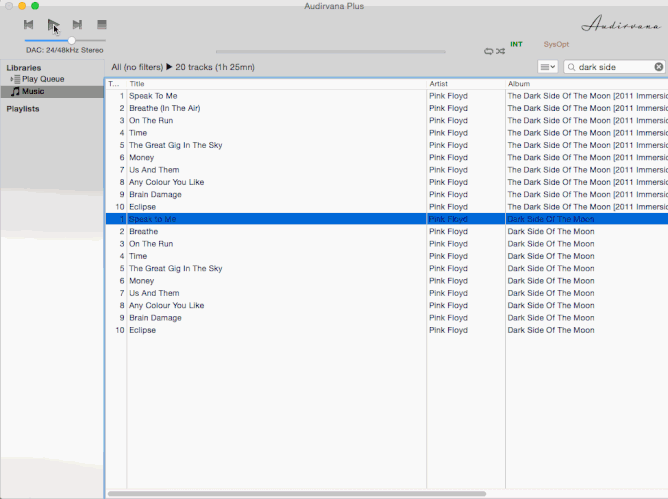@Mystic, Watch this blog closely. http://archimago.blogspot.com/2015/04/internet-blind-test-linear-vs-minimum.html
I’m sure it may be, but I’m not positive how albums are now mastered. I do know you want a separate 24bit master when cutting for vinyl.
But, IDK if the mastering engineer masters a separate 16/44.1 for CD or is the same 24bit master used for hi-res downloads just downsampled to 16/44.1?
Perhaps it would be helpful to get the views of Roon developers on this feature.
after 23 posts…
Is it just me, or are you just very good at sending out mixed messages? Going back to the start, you seem to have an objection to anything that might influence the SQ, so I am guessing you are a ‘bits are bits’ believer. And those bits are determined by the route to amplifier & speaker, hence the nice diagram.
What you seem to be missing is that in going through various pieces of hardware and equivalent DSP’s that the original sound has already changed. Aside from the recording & mastering equipment already having the engineers effects on the artist in the studio, the distribution and eventual route to speaker also goes through a fair few DSP’s. Taking consumer electronics in isolation, a typical DAC or streamer will have the DSP code set by the manufacturer. If that was not the case, we would all settle for one generic box and systems would be uniform. You must realise that every single part of the chain affects the eventual SQ. Including software.
So why not Roon, or any other ‘player’.
Bottom line is no-one is pushing Roon to take on HQ Player, or any other ‘player’, but it’s been said by themselves that they will probably implement something like memory play, and that they will introduce DSP enhancements eventually, talking to the writer of HQ Player is part of that process, does not mean that is what will be incorporated.
Like i said, if you do not like these bells ‘n’ whistles, then keep them switched off in your settings.
This is from a couple weeks ago.
That is still where we stand. At the moment, Roon is still a 32bit app on Mac/Windows, which makes RAM-based memory play totally impractical due to address space limitations. We’re in the midst of converting to 64bit right now, at which point we will be able to look at this feature more seriously.
A question for those familiar with Audirvana’s memory play:
It seems like Audirvana is pre-buffering/decoding the tracks during playback. I can see it buffering/decoding the track while the time ticker is ticking and audio is coming out (I have 13gb allocated to memory play:

The way their marketing material sounds, it feels like it should be making me wait to start playback while it decodes/loads into memory so as to completely decouple I/O and DSP activity from playback, but the behavior isn’t consistent with this. Am I missing something here?
(EDIT: click this image to see it animate vvv)
In my experience A+ has a vey slight lag before playback starts as it loads into memory. I think I have the memory allocated somewhere in the 8,000 MB range on my 16MB MacMini (late 2012)
@brian I think what it does is preloads the next track in the queue. So the first track loads into memory, this takes a few moments to start with, the music plays and towards the end of that track, it will preload the next item in the queue.
I definitely perceive a slight delay too (My analysis suggests that this is a delay while it opens/configures the audio device and possibly pre-rolls a small pad of silence).
For something simple like a 16/44 FLAC, the pre-buffering is very, very fast, and it might be very hard to tell what’s going on. I deliberately chose an expensive DSP use case for that animated GIF I posted (DSD64 -> 44100) so things would be slow enough that you could see how they actually line up in time.
Click that image to see it animate–does that jibe with what you’re seeing? If you play in one of these expensive conversion cases, does it make you wait, or does it play in parallel with decoding like it seems to for me?
Yes, that gif is the same thing as what happens when I play A+.
Yes, here too. That slight delay happens on the first track loaded. I have never had anything take too long to preload, but I am fairly sure that the music starts even while the track is loading, say for a 24/192 file. I would guess this might be determined by or related to how much RAM you allocate in the settings for use in memory play.
@brian What are your thought about improving sound?
@allenbretao Hi- I don’t mean to insult your intelligence or confuse you. I am serious as a heart attack about Music & audio and much of the technical side, for me, has to be supported by evidence.
It is just as important for those who love music to understand the technical side as it just important as those who love the technical side to understand music. This duality brings out true appreciation for the art.
I urge you not to take offense, because I too want great sound, I am just asking questions.
@brian What are your thought about improving sound?
I’m going to start with some background, and my philosophy on this stuff, then get to your point.
In terms of EM/RF noise, computers are noisy things, and in general, not a great thing to have near audio devices. From our perspective, the first class solution will always be to create some separation between the media server and the endpoint. USB is not a great choice for this. Ethernet is much better.
I have a nice DAC here that I use as a headphone amp and sits on my desk ~3ft away from 2 computers. Not going to name names, but it’s in the $1-2k range, and it’s very highly regarded at that price point. It’s plugged into computer A. If I play silence to the DAC from computer A, and scroll my web browser up and down on computer B, I can hear it in my headphones. They aren’t even directly connected.
This is what computer audiophiles are battling and, frankly, no matter what Roon does on computer A, it’s not going to stop that sort of interference from having an effect on SQ.
Computers are also complex, and don’t always emit a constant amount of EM/RF noise. So the idea behind a lot of what Audirvana does is: the more subsystems of the computer that can be disabled, moderated, or avoided, the less potential noise will be emitted. So it helps you turn off spotlight indexing (sysoptimizer), preload tracks into memory so we can stop dealing with the disk/ssd (at least most of the time, when pre-loading isn’t happening), and so forth.
This seems sound to me, and there’s no reason why Roon can’t provide some similar functionality in the future. It’s a nice thing to do, and not a huge effort, and it will make things better for people who drive their playback from a computer.
We come from a background in networked media servers, and we began actively moving away from playing audio from computers in the Sooloos hardware in 2009, because there were huge SQ benefits to be had by moving that way. We needed the benefits of a heavyweight media server, but we also needed the benefits of a lightweight audio renderer. The most elegant and complete solution is to put some separation in between them.
As for memory play specifically. I can see how it might help, since once you’ve pre-loaded, there’s less work going on in the computer (CPU can scale back down if there was DSP being pre-cached, and disk activity reduces significantly).
As an engineer, this feels like an unsatisfying solution. We can impact the noisiness of our computers by tiptoeing around their limitations and applying band-aids like sysoptimizer or memory play, or by hunting for system services to turn off. In the end, even with everything done “right”, there’s still a giant noisy motherboard, cpu, power supply, and gigabytes of RAM sitting there doing something. Almost no matter what, that is going to be noisier than a well-engineered embedded system built by people who understand and care deeply about sound quality.
This is where we are going with RoonSpeakers and why we are working with manufacturers to make networked endpoints a viable option for as many people as possible. This is where we see high-quality computer audio going–server on the computer, and endpoints driven over ethernet. It’s better for SQ, and takes pressure off of server software to be lightweight to the point where browsing functionality and metadata capabilities are sacrificed (a la Audirvana).
@brian I share this perspective too.
I am super excited about this!
Thank you for your lengthy and detailed repsonse. You’re awesome! 
Yes, thanks Brian!
I tried this tonight and I was not able to repeat your results.
iMac
MacBook Air
Audioengine D1
tracks were intro silence on Korn’s “Follow the Leader”
Grado SR80
Computers very close, 18"
My suspicions lie with the thunderbolt monitor plugged into computer B that sits right above the DAC. It’s backlit by a tube, has a busy USB hub built in that’s carrying the traffic to/from my mouse and keyboard, and has all of that high-frequency displayport junk going on.
That said, I have other DACs here (both cheaper and more expensive) that seem to resist interference better. The Meridian Explorer, even at $300, seems to be good at staying quiet when placed on the same desk, even though in general, it doesn’t sound as good.

